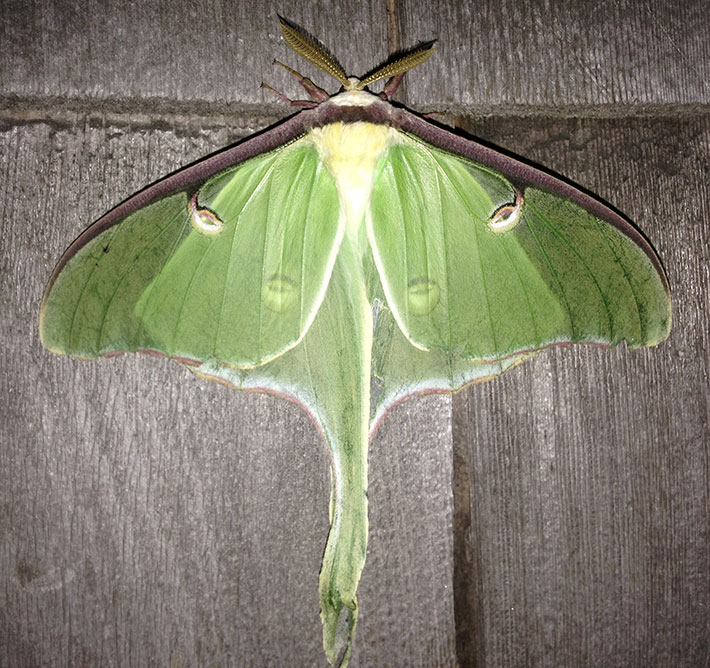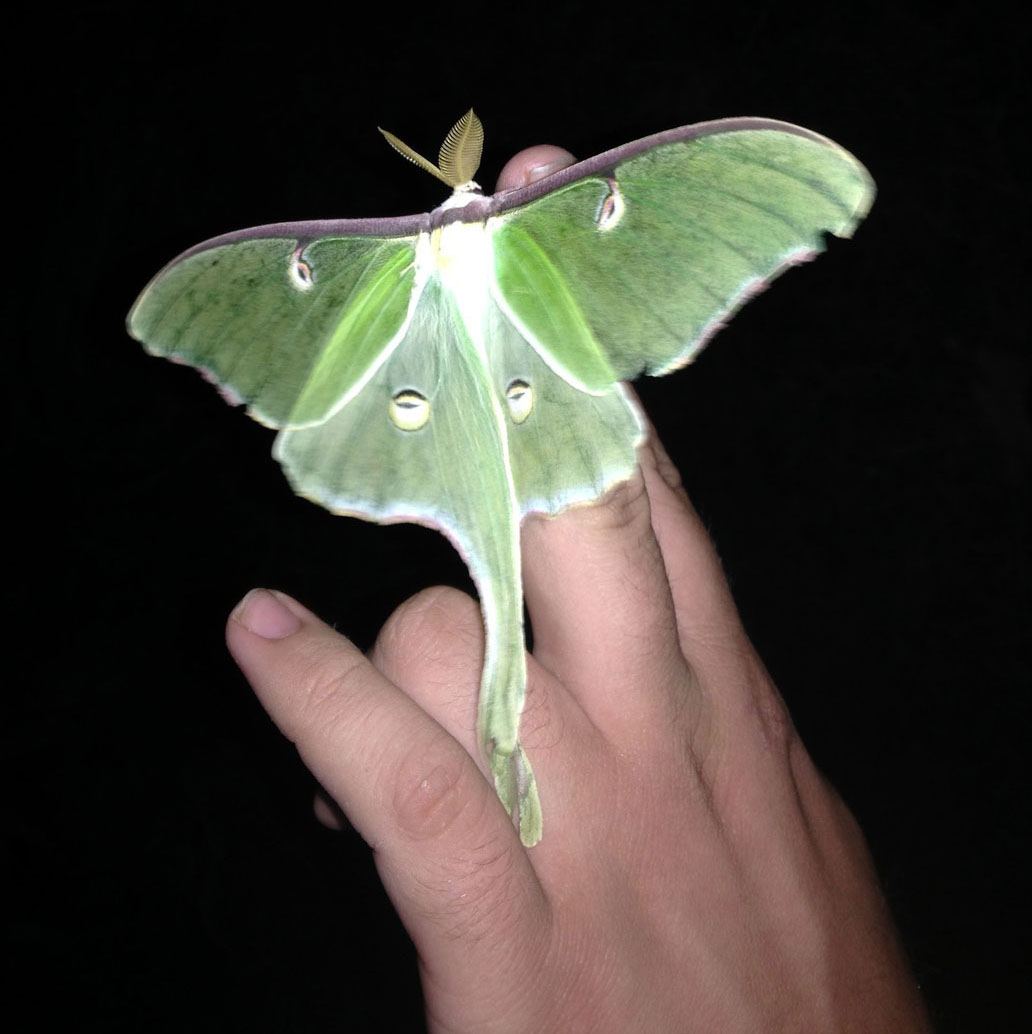
One of the most beautiful silkmoth species in North America. Male luna moth, June 15, 2016, Fishers Island, New York.
I collected this male from a light trap around midnight and released him after a few pictures. You can tell the males apart from females in most silkmoths by the large, feathery antennae, which they use to “smell” pheromones of females, up to miles away!
Common name: Luna moth
Scientific name: Actias luna
Food: Luna moths feed on a variety of woody plants as caterpillars, including birches, persimmons, walnuts, sweetgums, and sumacs.
Ecology: As adults, they do not feed, and rely on the energy they consumed during their caterpillar stage to keep them alive until they find a mate. Unfortunately, they only live a few days after emerging from their cocoons.
Luna moths have been in severe decline for the past century. There are many reasons why: habitat loss through loss of native host plants, the introduction of parasitic flies and wasps that attack the caterpillars, and artificial light from buildings and streets that attract adults all contribute to population decline.

This image gives perspective to magnificent male luna moth.
Adam Mitchell Photos
Greater Grapevine Looper
FI MothsCommon Name: Greater grapevine looper
Scientific Name: Eulithis gracilineata
Season: Two generations, with caterpillars by June and adults in July.
Food: Grape and Virginia creeper.
Ecology: Many caterpillars feed at night to avoid being detected by birds, but they need a clever way to avoid being noticed while they rest during the day. The greater grapevine looper mimics the appearance of a twig, and will hold itself straight and still for extended periods of time to avoid detection. Eggs that are laid in the fall or late summer will overwinter.
Doug Tallamy Photo
Forest Tent Caterpillar and Moth
FI MothsCommon Name: Forest tent caterpillar
Scientific Name: Malacosoma disstria
Season: One generation per year, with caterpillars in late spring to early summer, and adults soon after.
Food: Alder, basswood, birches, cherries, oaks, poplars, and willows. Adults do not feed.
Ecology: Although related to eastern tent caterpillars, forest tent caterpillars don’t form “tents”. Instead, they form large silken mats near the base of branches or the tree itself, where they gather in large numbers, sometimes in the hundreds, to molt or to rest. When a caterpillar leaves the mat to look for food, it leaves behind a trail made of silk. Like a trail of bread crumbs, the caterpillars follow the silk trail left behind in search for tender leaves. Forest tent caterpillars, like the eastern tent caterpillar, may defoliate the trees they feed on, but rarely do they ever kill their host plants. The eggs overwinter and hatch the following spring.
Doug Tallamy Photo
Forest tent caterpillar moth. Adam Mitchell Photo
Alianthus webworm
FI MothsCommon Name: Alianthus webworm
Scientific Name: Atteva aurea
Season: At least two generations in the northeast, and more likely to increase due to climate change. Adults by May, and caterpillars throughout the summer and into fall.
Food: Tree-of-Heaven, an invasive species. Its native host plant can only be found in southern Florida and into the tropics. The adults take nectar from flowers.
Ecology: Originally, this species could only be found in southern Florida. However, since the introduction of the invasive plant Tree-of-Heaven (Alianthus altissima) and climate change, the Alianthus webworm has since spread north. If the moth if found on your property, it is likely that Tree-of-Heaven plants are somewhere nearby. Caterpillars form nests made of silk, and eat the leaves within.
Doug Tallamy Photo
Green Marvel
FI MothsCommon Name: Green Marvel
Scientific Name: Acronicta fallax
Season: Two generations in New England; mature caterpillars in June and July, and again from August into October. Moths from late May into June, and again in late July. Caterpillars in the fall overwinter as pupae.
Food: Viburnum
Ecology: The Green Marvel earns its name well with the bright green and black patterning across its wings, which help the moth blend into lichens and moss on the bark of trees during the day. It can be found in forests and scrub meadows where viburnum bushes are common. As caterpillars, they hide on the underside of leaves to feed. When the caterpillars are ready to pupate, they tend to tunnel into soft wood to help protect themselves from being fed on.
Doug Tallamy Photo
Azalea Sphinx
FI MothsCommon Name: Azalea sphinx
Scientific Name: Darapsa choerilus
Season: At least two generations a year, with adults by June and caterpillars onward.
Food: Caterpillars feed on azalea, black gum, blueberry, grape, and viburnum. Adults take nectar from flowers.
Ecology: Like many sphinx moths, the Azalea sphinx is diurnal, meaning it is active during the daytime. Adults take nectar from flowers with their long tongues, and prefer elongate, tube-like flowers. As such, these moths are pollinators, and provide an important service to the environment. Caterpillars will move to the base of their host plant and form a silken cocoon out of dead leaves. Caterpillars overwinter as pupae.
Adam Mitchell Photo
Photo by: Douglas Tallamy, Entomologist
Pandorus Sphinx
FI MothsCommon Name: Pandorus Sphinx
Scientific name: Eumorpha pandorus
Season: Some places see only one generation a year, while others see two.
It is a large, greenish gray moth with darker patches and pink edges and small pink eyespots. The underside is usually pale yellow-green or brown. It has a wingspan of 3¼–4½ inches (8.2–11.5 cm), females being slightly larger than males. Pandora sphinx moths fly during dusk.
Adam Mitchell Photo
Luna Moth
FI MothsOne of the most beautiful silkmoth species in North America. Male luna moth, June 15, 2016, Fishers Island, New York.
I collected this male from a light trap around midnight and released him after a few pictures. You can tell the males apart from females in most silkmoths by the large, feathery antennae, which they use to “smell” pheromones of females, up to miles away!
Common name: Luna moth
Scientific name: Actias luna
Food: Luna moths feed on a variety of woody plants as caterpillars, including birches, persimmons, walnuts, sweetgums, and sumacs.
Ecology: As adults, they do not feed, and rely on the energy they consumed during their caterpillar stage to keep them alive until they find a mate. Unfortunately, they only live a few days after emerging from their cocoons.
Luna moths have been in severe decline for the past century. There are many reasons why: habitat loss through loss of native host plants, the introduction of parasitic flies and wasps that attack the caterpillars, and artificial light from buildings and streets that attract adults all contribute to population decline.
This image gives perspective to magnificent male luna moth.
Adam Mitchell Photos
Io moth
FI MothsCommon Name: Io moth
Scientific Name: Automeris io
Season: Usually two generations in the Northeast.
Food: Feeds on many different trees, shrubs, legumes, and grasses (this one was feeding on black locust).
Ecology: Adults emerge during late morning or early afternoon, and mating takes place in the late evening. Females lay clumps of eggs on leaves or stems of the host plants. Young caterpillars feed together as a group and move in long “trains” while older caterpillars feed alone. Papery cocoons are spun in litter under the host plant or in crevices.
Adam Mitchell Photos
Caterpillars of the io moth are dangerous to touch, even young caterpillars such as these (mature caterpillars become green). The large spines that protrude from their backs can cause a stinging sensation to the fingers, similar to stinging nettle. The adults, however, are harmless.
Weed Team 2017
grasslands restorationThree University of Delaware undergraduates and Adam Mitchell, PhD student (right), clear invasives in Parade Grounds. Justine Kibbe Photo
On June 3, 2017, three University of Delaware (UD) students arrived on Fishers Island with a few bags of food, backpacks, and a handful of garden shears. Employed by the Fishers Island Conservancy, and trained and supervised by both UD professor, Douglas Tallamy, PhD. and his graduate student, Adam Mitchell, the Weed Team was ready for battle.
Read the full story
Wildlife Monitoring and Connecting with the Natural Environment
SentinelsMy name is Erik Blomquist, and I have been fortunate enough to call Fishers Island a second home my entire life. Since I was little, I have come to the island to visit my grandparents and experience the unique little world that is Fishers Island. It was at a young age that I began finding undeniable interest in the natural world, always being told by my grandpa, John Ski, to “observe nature”.
For the past seven years, I have spent summers on Fishers working various jobs. Last summer, I worked as an intern for the Fishers Island Conservancy doing basic invasive plant species removal, mostly throughout the Parade Grounds. I worked alongside Adam Mitchell and Joe Henderson, helping to make progress in the projects they envisioned for that specific area.
After making only a tiny dent in overall removal goals for the Parade Grounds, I began thinking of ways to ramp up removal of these invasive species. Down a somewhat unexpected avenue, I found the means to further the progress in the battle against invasives.
During the off-season, I was given a spot on the Island Sentinels team. Justine Kibbe gave me the opportunity to create my own project to add to the Island Sentinels program. My project is still developing into a monitoring site that will encompass a portion of the Parade Grounds, from Airport Road east towards the movie theater, all along the Fort stretch. It will be a monitoring site, where we can observe and record invasive plant species.
Monitoring will be ongoing over the summers so we can gain awareness of how quickly and aggressively these species are taking over the area. My goal is that by recording the location and density of these invasive plant species, we can formulate an appropriate removal and restoration plan. The end result is to eventually see a healthier Parade Grounds habitat.